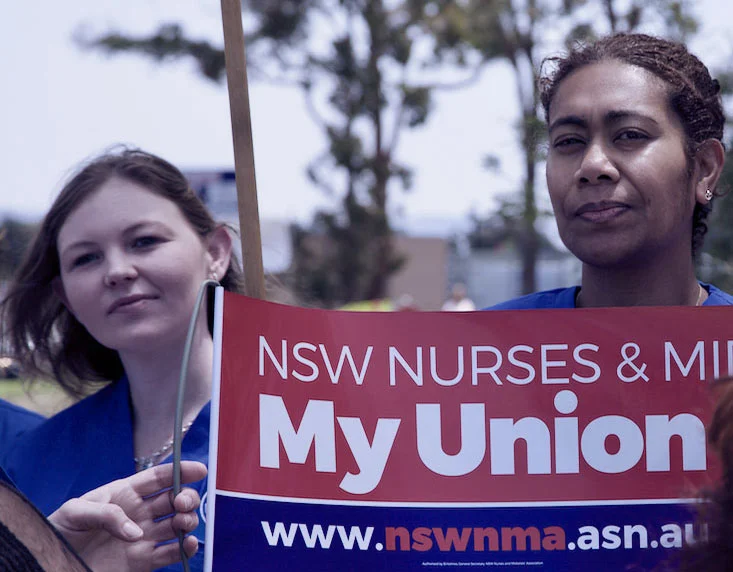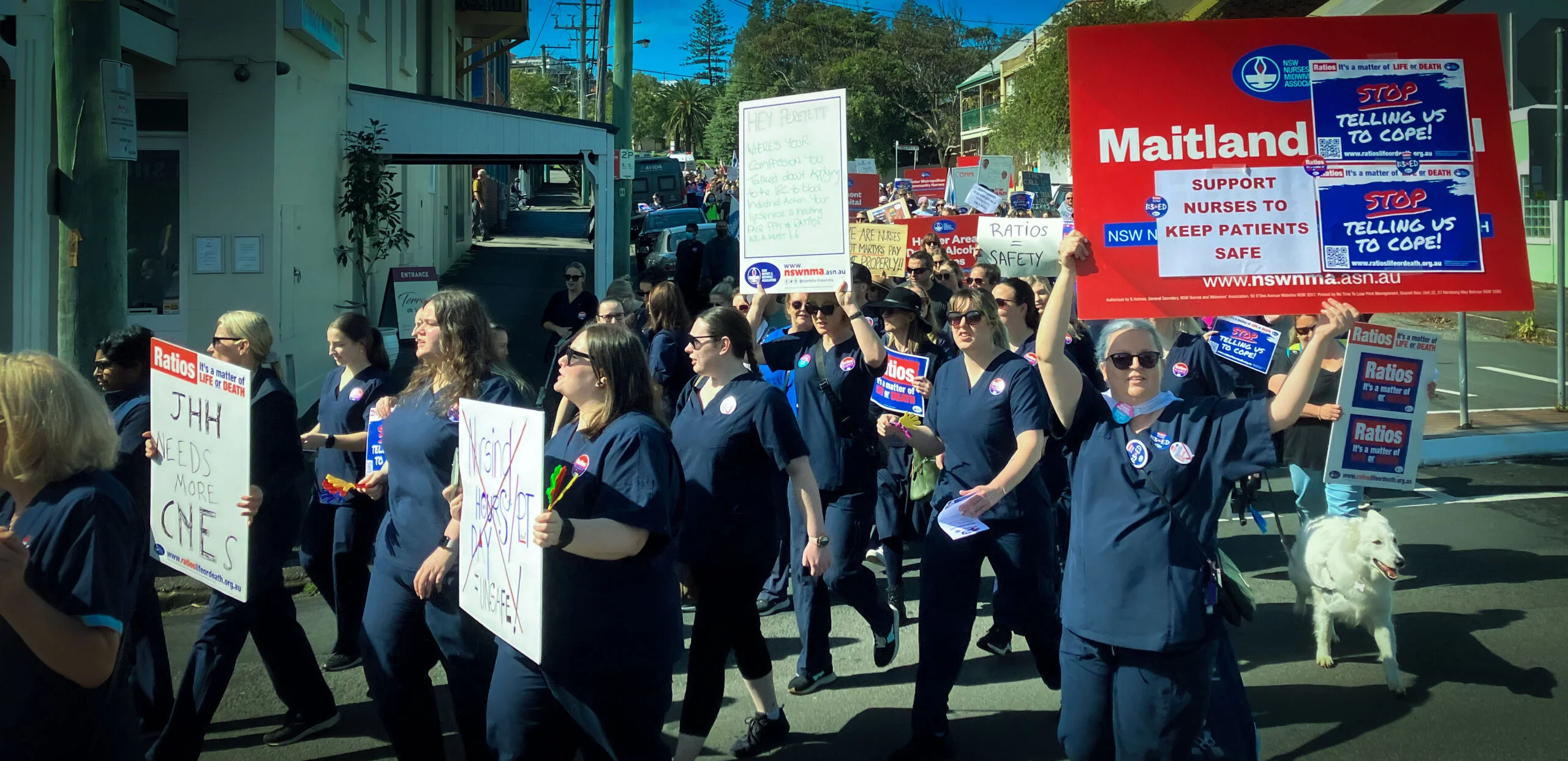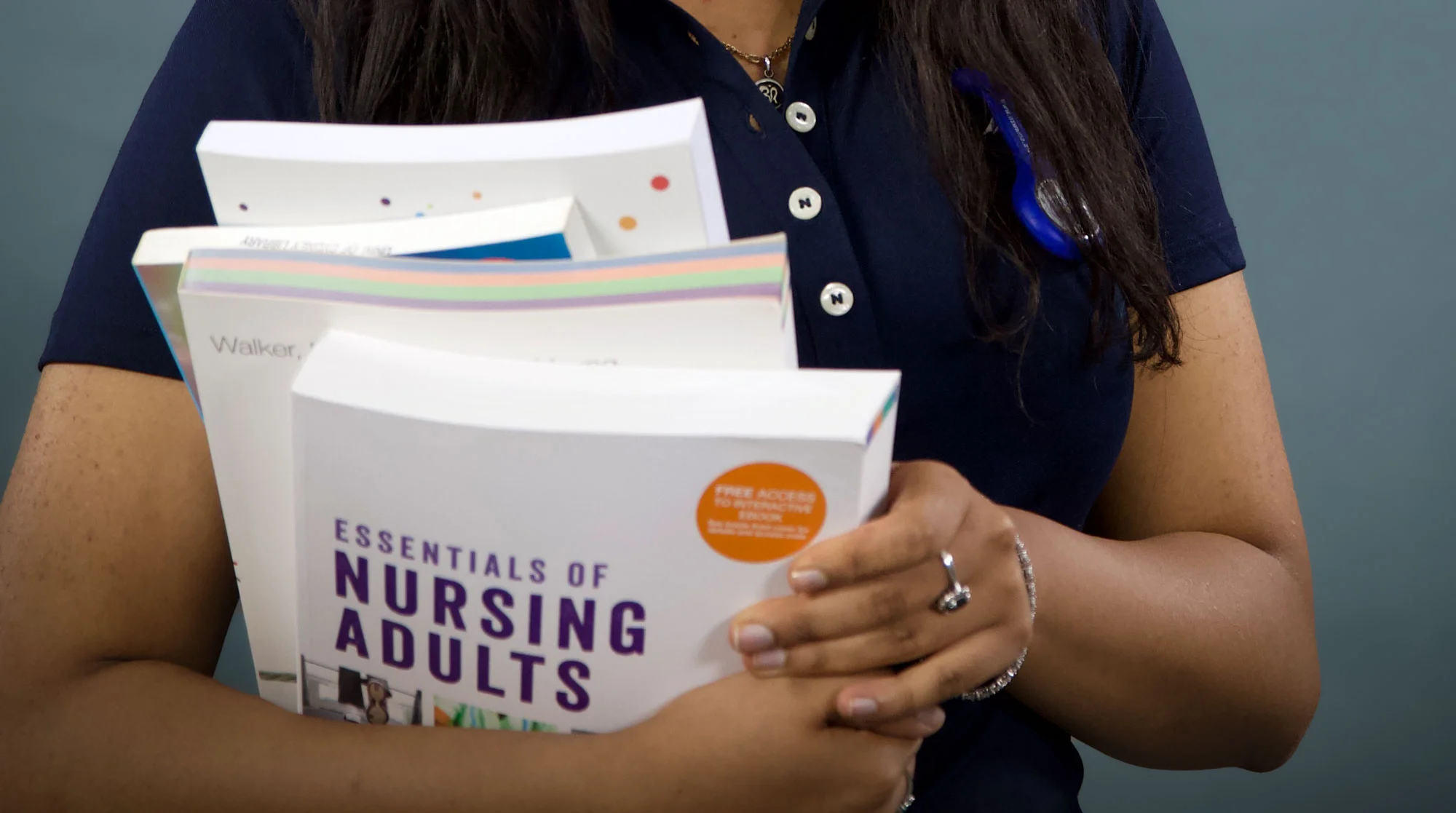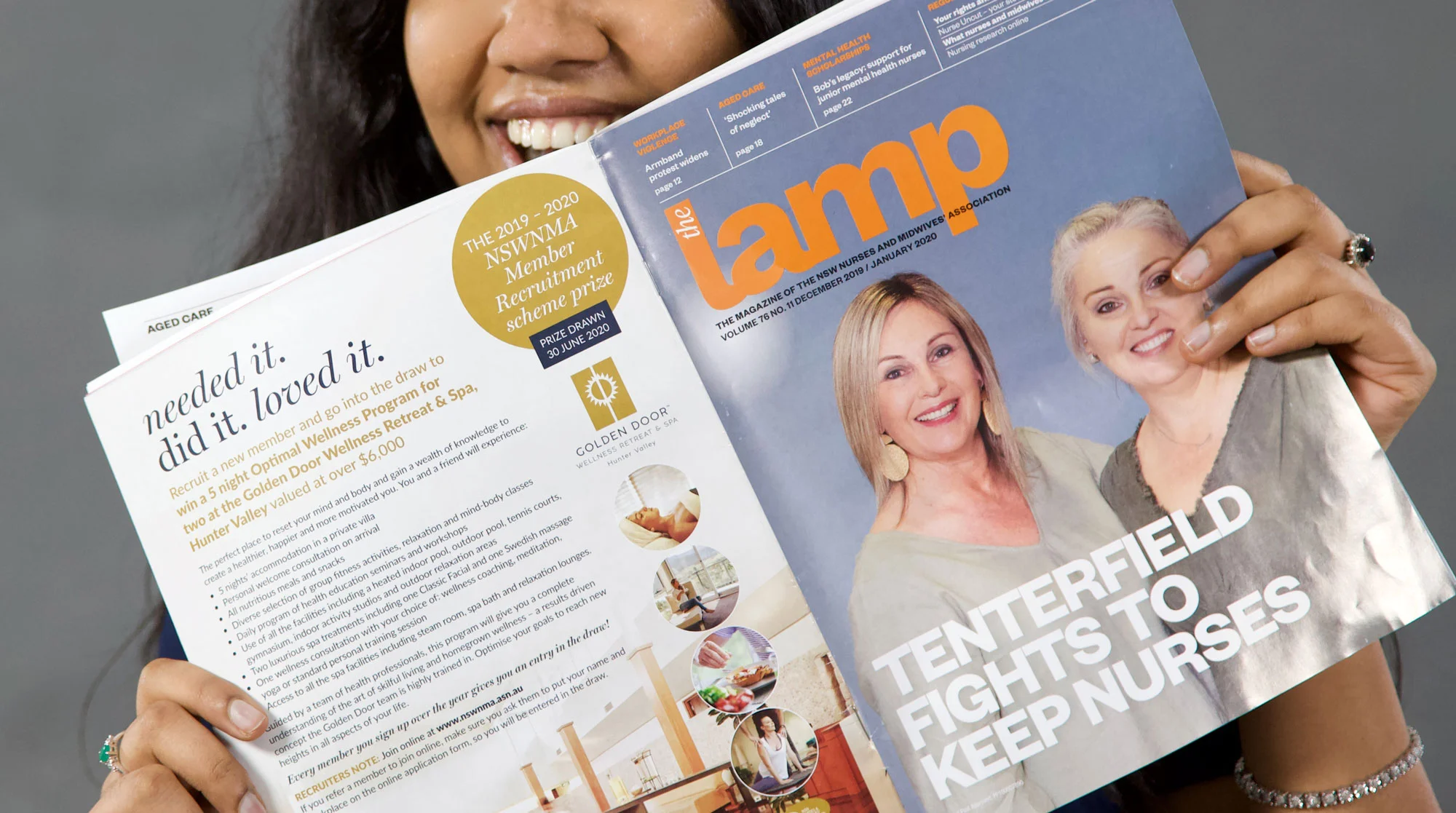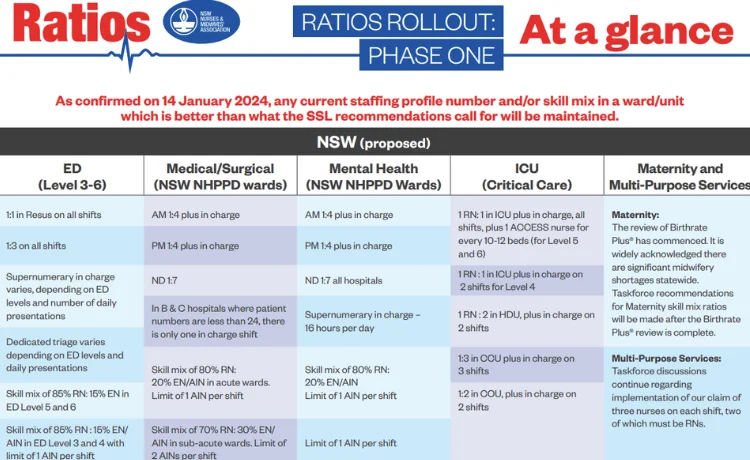Ratios in the Public Health System
Stay up to date on the rollout of ratios
Following four historic statewide strikes in 2022, which convinced the incoming Labor government to pursue the introduction of ratios in public health, we saw the establishment of the Safe Staffing Levels Taskforce in April 2023.
This initiative has seen representatives from the NSW Nurses and Midwives’ Association hold regular meetings with the Ministry of Health and at times, the Health Minister’s office. Together, the parties have been working to chart the delivery of ratios in five key areas of public hospitals.
In September 2023, the NSW government outlined its first budget. While it went some way towards easing the decade-long neglect of the public health system, the reality is more must be done to achieve the reforms we have been fighting for.
Almost $1 billion was allocated for nursing and midwifery positions to help deliver ratios in public health. However, the current funding allocation is not enough to roll out ratios in every hospital, ward, and unit within the five designated specialties over the next four years. Our message to the government is clear: serious health reform is not negotiable.
The NSW government must expand the spread of ratios and deliver further improvements to your pay and conditions. This is a fight we will take up to the next state budget in June 2024.
In February 2024, the NSWNMA secured agreement on the first phase of the ratios rollout. For the first time, NSW will have minimum and enforceable shift by shift nurse-to-patient ratios implemented in specific clinical areas of public hospitals, which is a major milestone in the NSWNMA’s longstanding fight for reform.
There is still a lot of work to be done to ensure the staffing enhancements are introduced in every hospital and every ward across the state. We will be continuing to campaign hard to achieve ratios in the many specialty areas that are not yet covered by the Safe Staffing Levels policy.
Where are we up to?
22 April 2025
Although protracted, the progression of Phase One of the rollout has continued. Many Level 5 and Level 6 Emergency Departments are mid-way through recruitment, with five sites meeting their full allocation. See list of complete and incomplete NSW Level 5 and 6 EDs below.
A proposed implementation timeline is being developed to expand the rollout across Level 3 and Level 4 Emergency Departments. More information will be shared with members once this timeline has been negotiated.
While this is a definite step forward, there is still much more to do. Hundreds of hospitals and wards are still without SSL, and some workplaces, such as affiliated health organisations, are yet to be included in the rollout.
With the current state of our health care system in crisis and without a genuine pay rise that adequately values the work you do, there will not be enough nurses and midwives left in NSW to implement ratios in full across our state.
We need the government to come back to the table and put forward a meaningful offer. Keep the conversation going with friends, family, and the broader community – send a text message now to encourage them to sign our petition.
Click here to find out more about our current campaign for fair pay.
Complete and incomplete NSW Level 5 and 6 EDs
| Hospital | Department | SSL recruitment status |
| Bankstown hospital | Emergency Department (Level 6) | Incomplete |
| Blacktown Hospital | Emergency Department (Level 5) | Incomplete |
| Campbelltown hospital | Emergency Department (Level 5) | Incomplete |
| Coffs Harbour Base Hospital | Emergency Department (Level 5) | Incomplete |
| Gosford Hospital | Emergency Department (Level 6) | Complete |
| John Hunter Hospital | Emergency Department (Level 6) | Complete |
| Lismore Base Hospital | Emergency Department (Level 5) | Incomplete |
| Liverpool Hospital | Emergency Department (Level 6) | Complete |
| Nepean Hospital | Emergency Department (Level 6) | Complete |
| Orange Base Hospital | Emergency Department (Level 5) | Incomplete |
| Port Macquarie Base Hospital | Emergency Department (Level 5) | Incomplete |
| Royal North Shore Hospital | Emergency Department (Level 6) | Complete |
| Royal Prince Alfred Hospital | Emergency Department (Level 6) | Complete |
| St George Hospital | Emergency Department (Level 6) | Incomplete |
| Tamworth Hospital | Emergency Department (Level 5) | Complete |
| The Children’s Hospital Westmead | Emergency Department (Level 6) | Complete |
| Wagga Wagga Hospital | Emergency Department (Level 5) | Incomplete |
| Westmead Hospital | Emergency Department (Level 6) | Incomplete |
| Wollongong Hospital | Emergency Department (Level 6) | Incomplete |
Last updated 13/06/2025
Previous updates
The NSW government has confirmed the next stage of the ratios rollout is now underway, and recruitment efforts are ramping up at an additional 12 hospitals to help deliver safer staffing levels in some of our busiest emergency departments, including:
|
|
|
This follows earlier announcements of ratios coming to Liverpool, Royal North Shore, Lismore Base, and Port Macquarie Base hospitals.
Though this is a step in the right direction, there is still much more to do. With more than 200 public hospitals in need of safer staffing, Labor has barely scratched the surface since coming to power. The Ministry of Health must move swiftly to support our public hospitals. Without a genuine pay rise that adequately recognises the important work you do, there will not be enough nurses and midwives to see ratios implemented in full across our state.
We are standing strong in this fight, but we need to spread our message. Community support is key to ensuring the state government and the Ministry of Health hear us loud and clear: nurses and midwives deserve more in 2024.
Click here to find out more about our current campaign for fair pay.
The NSWNMA welcomes the announcement of nurse-to-patient ratios at two regional NSW hospitals, to help alleviate pressures on staffing in emergency departments (ED) but we are concerned over the pace of the phased rollout.
Lismore Base Hospital will receive an additional 29 full-time equivalent (FTE) nurses and Port Macquarie Base Hospital will receive 13 FTE, to meet the ratio of one nurse to every three treatment spaces in the ED.
But only four out of more than 200 public hospitals have started receiving nurse-to-patient ratios since the Labor government was elected last year. We know many hospitals are struggling with staffing shortages and need shift by shift minimum and enforceable ratios urgently.
We need the Ministry of Health and state government to speed up the safe staffing rollout, to ensure it is implemented smoothly and swiftly.
The NSWNMA is continuing to negotiate with the state government on its 2024 pay and conditions claim, after the current Public Health System Nurses’ and Midwives’ (State) Award expired on June 30.
Recruitment is underway for the state government’s Safe Staffing Levels Policy, with the first nurses starting as part of nurse-to-patient ratios.
The NSW government has confirmed the ratios rollout is beginning at Royal North Shore and Liverpool hospital’s emergency departments.
Around 70 additional full time equivalent nurses are being recruited across both sites to meet the minimum ratio of one to one in resuscitation bays, and one nurse to three generally occupied treatment spaces in ED, with the aim of building a sustainable workforce and improving timely emergency care for patients.
After more than a decade of campaigning for minimum and enforceable shift by shift ratios, the NSWNMA is excited that this important healthcare reform is finally becoming a reality.
The NSW government announced significant reforms to the state’s public health system to begin in March following a hard-fought campaign to deliver minimum and enforceable shift by shift nurse-to-patient ratios in specific clinical areas.
Negotiations with the state government and the Ministry of Health have been extensive in recent months, and this follows a decade-long battle to reform the state’s health care system.
Though this has been a long journey, nurses and midwives can be proud of their efforts to bring on such landmark reforms! It is only through our members’ determination that we have been able to secure these commitments to improve conditions for nurses and midwives, and their patients.
The detail
Under the Safe Staffing Levels policy, a 1:3 ratio will be phased into Emergency Departments (EDs) on all shifts, and 1:1 in resuscitation bays. For critical care, ratios will be 1:1 in Intensive Care Units and 1:2 in High Dependency Units. For the first time, the role of ACCESS nurses in ICUs will be protected, and in Nursing Hours Per Patient Day wards a ratio of 1:4 will apply.
The Ministry of Health has said the first ratios rollout will begin during March, starting in ED at Liverpool and Royal North Shore Hospital’s, with other EDs and wards to follow. This means we will start to see improved workloads for members, and greater assurances around safe emergency care for patients.
This will also mean an end to the rorting of staffing levels that so many nurses and midwives have reported in recent years. Greater transparency and accountability will be a focus of these reforms, and previous cost-cutting approaches to staffing will be a breach of the Award.
The use of Assistants in Nursing (AiNs) will be regulated with a maximum number per shift. AiNs will not be counted in ratio numbers in ICUs or in Level 5 and 6 EDs. The Ministry of Health has written to Chief Executives and Directors of Nursing & Midwifery to make clear what is expected under these reforms; a transparent, accountable and enforceable staffing system.
This fight for safer staffing levels has been long and tough, and we’ve seen far too many experienced nurses and midwives exit the state’s health system because NSW has simply fallen behind. We believe these reforms are an important step in rebuilding confidence in public health in this state.
More work ahead of us
The NSWNMA will continue working with the state government on the implementation of ratios in Intensive Care Units, Medical and Surgical wards, and Mental Health. Discussions also continue for Multi-Purpose Services in regional communities, and for Maternity services, with a review of the Birthrate Plus system underway.
This is a foundation from which to build on, and we recognise and acknowledge that this fight must go on.
These reforms are a gamechanger for many nurses and midwives and will provide assurance around staffing after such a long period of neglect by the former NSW government. We cannot afford another decade of inaction, that is why we’ll continue to fight for all nurses and midwives to have access to ratios.
Campaigning for fair pay
We recognise that this fight is about more than just delivering ratios. No nurse or midwife should have to choose between safe workloads and fair pay. The government must accept that in the current financial climate, nurse and midwife pay must also improve. The next pay negotiation will be a key focus for the NSWNMA.
Further improvements for nurses and midwives, and the patients you care for, will not come without a fight, but together we are stronger. What we have already achieved proves exactly this.
Following feedback from NSWNMA public sector members over the past 10 days, the Ministry of Health and the Health Minister have today (Sunday, 14 January) agreed to amend certain areas of the Safe Staffing Levels Taskforce recommendations to implement ratios in NSW.
Importantly, this means your voices have been heard loud and clear. The Ministry has agreed that no ward or unit will be worse off under the implementation of Safe Staffing ratios, and proposed skill mix provisions within Intensive Care Units have been removed.
Staffing and skill mix protections
This clause will be inserted into the Public Health System Nurses’ and Midwives’ (state) Award, as part of the section outlining the Safe Staffing Levels:
If at the time of implementation of the staffing level outlined in this clause, there are wards/ units with staffing profile numbers higher than the specified staffing and skill mix, the existing staffing numbers and skill mix in those wards/units will either continue to apply or be subject to prior review and variation. A reduction in staffing profiles or numbers, or a reduction in skill mix, will not occur without a review that considers the clinical needs in the ward or unit taking place. If there is disagreement between the Employer and Association about the outcome of the review the provisions of clause 48, Disputes, will apply.
This means that any current staffing profile number and/or skill mix in a ward/unit which is better than what the SSL recommendations call for will be maintained. Under this clause on any ward or unit where SSL is implemented,
- Staffing numbers can’t be reduced
- AINs can’t be introduced into a staffing profile where they don’t currently exist, and
- the percentage of RNs can’t be reduced,
unless there is a review undertaken which considers clinical need. If the NSWNMA doesn’t agree with the outcome of the review, the matter can be taken to a Dispute, including to the NSW Industrial Relations Commission if necessary.
Safe staffing ratios are a minimum, wards and units which have higher staffing numbers and/or better skill mix should keep them.
Intensive Care Units
The following table outlines a guarantee that all patients requiring ICU and HDU care will be nursed by an RN, except in Level 4 ICUs where ENs currently employed will continue to be counted in the 1:1 or 1:2 ratio. AiNs will not count toward the safe staffing levels for ICUs.
The above Staffing and skill mix protections will also apply to all ICUs and HDUs, that is, existing superior staffing will be maintained.
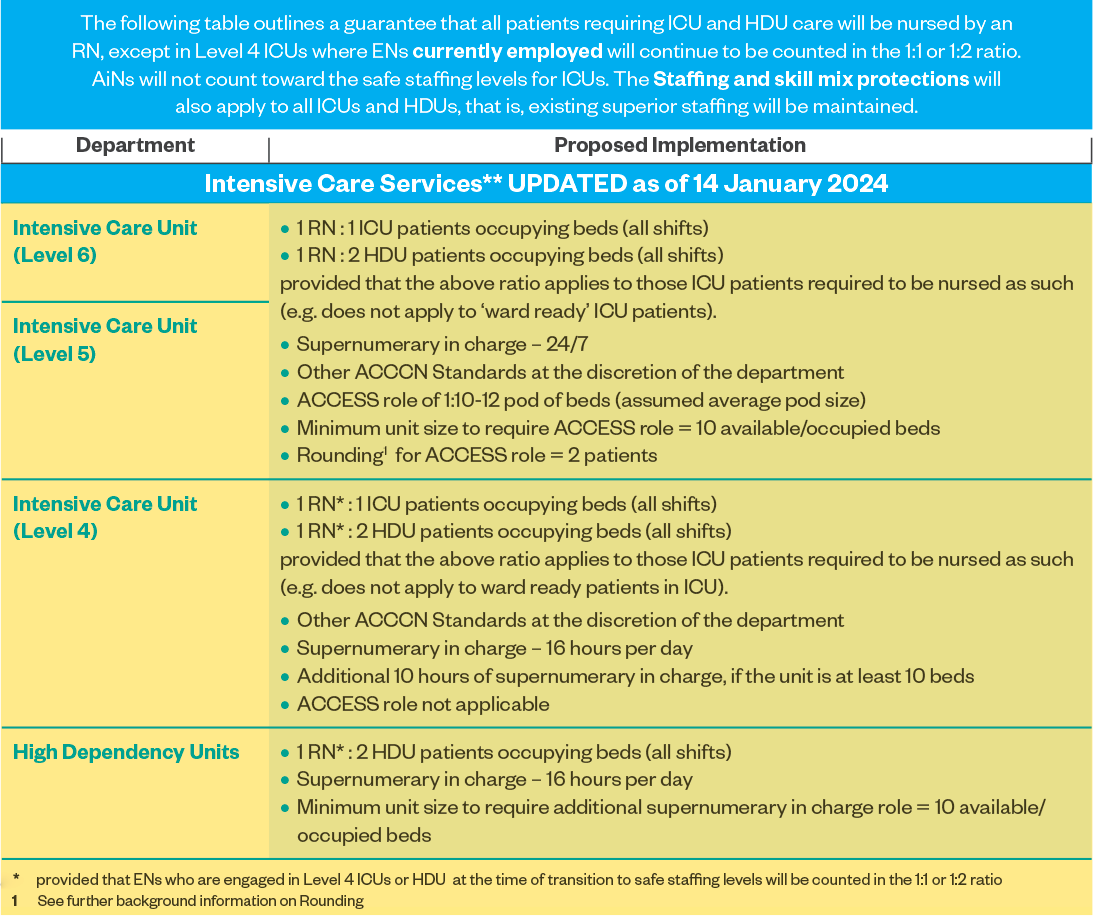
The NSWNMA Council and leadership welcome these amendments to the Safe Staffing Levels Taskforce recommendations.
All public sector branches are asked to meet and vote on the updated Taskforce recommendations between 15-25 January 2024. We strongly encourage you to take part and have your say.
To help members to make an informed decision, the following updated resources are available:
- The full Taskforce recommendations – comprehensive details of the updated shift by shift ratios and skill mix proposal;
- At a glance summary – snapshot of what is proposed, including today’s updates;
- State-by-state comparison – of ratio systems across the country;
- Ratios rollout FAQ – a summary of key questions relating to phase one.
NSWNMA Council recommends branches vote ‘Yes’ to accept the updated Taskforce recommendations, as they represent a strong safe staffing ratios foundation on which we can build.
Over the past nine months, representatives from the NSWNMA and NSW Health have met more than 20 times to develop a plan to phase in ratios in NSW public hospitals.
The government-appointed Safe Staffing Levels Taskforce (SSL) has made recommendations for how ratios should be implemented within the five specialty areas agreed to by the NSW government.
These recommendations, reached by the SSL in December 2023 and subsequently reviewed by the NSWNMA Council, must now be reviewed by NSWNMA public sector branches.
All public sector branches are asked to meet and vote on the Taskforce recommendations between 15-25 January 2024. The NSWNMA is using the next two-weeks (until 15 January) to provide information to public health sector members prior to branch meetings, so as many members as possible can be fully informed.
To better understand what is being proposed, we have developed resources to help members make an informed decision:
- At a glance summary – offers an easy digest of what is being proposed;
- State-by-state comparison – to help understand the complexity of ratio systems across the country;
- the full Taskforce recommendations – comprehensive details of the proposed ratios and skill mix you and your fellow branch members are being asked to vote on;
- Ratios rollout FAQ – a summary of the key questions relating to phase one of this proposed rollout.
Your NSWNMA Council has fully considered and endorsed these recommendations to go to a vote of public sector branches.
After months of extensive negotiations, and taking into consideration what the Government is seemingly prepared to offer, Council and the Elected Officers are convinced that these talks have stretched as far as possible.
Council recommends branches vote ‘Yes’ to accept the recommendations. Though they are not perfect, this represents an opportunity for us to build a strong safe staffing foundation.
This is an important piece of reform, and we strongly encourage our branch members to take part in this vote to help determine the path forward.
The Association continues to hold talks with the Ministry of Health regarding the implementation of minimum and enforceable ratios in five key areas across a schedule of workplaces.
Earlier this year, the Safe Staffing Levels Taskforce began this work with the ambition of firming up this rollout schedule by the end of October.
However, as flagged in the past few weeks, the Association recently sought the intervention of the Health Minister after talks with his ministry reached an impasse.
We now believe all parties are achieving progress in good faith, but what is clear is that more work is needed to clearly define the implementation of our ratios claim, and therefore the scope of the schedule.
NSW Health cannot prepare a schedule for the rollout of this reform until we have agreed on the implementation of our ratios claim within the safe staffing levels. Whilst we need the rollout to start as soon as possible, the Association is acting to ensure we achieve as much reform as possible within this round of funding.
We’re committed to ensuring the new staffing system is transparent, accountable, and enforceable – and we continue to stress this in these negotiations.
The Association has held productive talks with the Ministry of Health and all parties, including the Health Minister, believe progress has been made in good faith as to how ratios shall apply.
Attention has now shifted to finalising the implementation detail coming out of the Safe Staffing Levels Taskforce. This will allow us to bring comprehensive information to members for your consideration.
We have been determined to ensure this new ratios system is transparent, effective and enforceable, and although we have experienced delays in this process, we maintain these requirements are essential to delivering real and systemic change in the long term, and that we cannot proceed without them.
The Association held further discussions with the Ministry after analysing data shared with the Safe Staffing Levels Taskforce. Despite our efforts to negotiate to ensure this rollout is successfully delivered, there were still a number of matters that the parties were unable to reach agreement on.
As a result, the Association sought intervention from Health Minister Ryan Park to work with both the union and his Ministry, in an effort to find a path forward.
Talks with the Minister and the Ministry are set to continue and further updates will be provided once available.
After more than a decade of neglect and decline under the former government, it is Labor’s duty to do what is right and ensure this policy is implemented as it was intended.
On 19 September, the state government shared the details of its first budget. While the budget went some way towards easing the decade-long neglect of the public health system, the reality is that more still needs to be done to achieve the reforms we have been asking for.
Almost $1 billion was allocated for nursing and midwifery positions to help deliver ratios in public health. However, the current funding allocation is not enough to roll out ratios in every hospital, ward, and unit within the five designated specialties over the next four years.
Click below to hear our assessment of the budget.
The Association signed a Memorandum of Understanding with NSW Health. This binds both parties into ensuring ratios go into your Award and will then be implemented via a scheduled rollout.
In the most recent round of talks, the Association continued to examine the scope of FTE that is available, how the schedule will firm up, and what the rollout will look like into the future.
Please click below for more.
The Association continued meeting with the Ministry of Health as part of the government’s Safe Staffing Levels Taskforce.
The most recent round of talks centred on how this ratios claim will apply. Specifically, the Association assessed the Ministry’s data around the full-time equivalent (FTE) level required to convert all workplaces within the five areas to a ratios model, vs. the amount of FTE in the current budget.
Please click below to hear where things stood.


